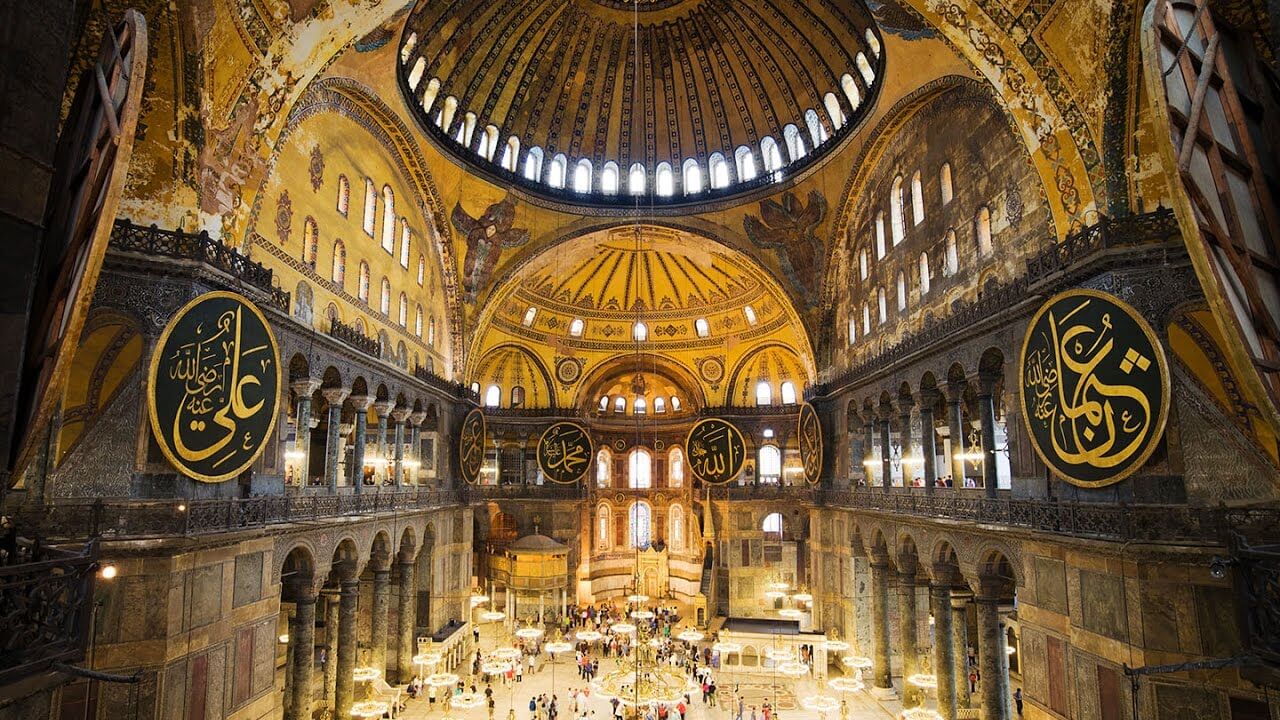Hagia Sophia: History and Architectural Grandeur
Known as Hagia Sophia (or Ayasofya in Turkish), this imposing structure stands as a living testament to the grandeur of Byzantine art and architecture. Throughout its history, Hagia Sophia has served as a church, a mosque, and finally a museum, solidifying its place as one of the most iconic and visited monuments in Istanbul. Renowned for its beauty, scale, and functionality, it is considered one of the architectural wonders of the world.
History of Hagia Sophia
The first version of Hagia Sophia was built in 360 AD during the reign of Emperor Constantius, son of Constantine the Great. Initially, it served as a Byzantine basilica dedicated to Christian worship. However, the church was destroyed twice: first in 403 AD during a popular revolt and again in 532 AD during the Nika riots.
The current structure of Hagia Sophia was commissioned by Emperor Justinian I and constructed between 532 and 537 AD. Justinian spared no expense, using materials from across the Roman Empire, including white marble from the island of Marmara, green porphyry from Euboea, pink marble from Afyon, yellow marble from North Africa, and columns from the Temple of Artemis in Ephesus. Historical records suggest that over 100,000 workers participated in the construction of this colossal monument.
In 1453, following the Ottoman conquest of Constantinople, Sultan Mehmed II ordered Hagia Sophia to be converted into a mosque. Islamic elements such as the mihrab, the minbar, and the four surrounding minarets were added. In 1935, under the direction of Mustafa Kemal Atatürk, Hagia Sophia was transformed into a museum, symbolizing the secular era of the Turkish Republic.
Restoration and Preservation
Over the centuries, Hagia Sophia has undergone numerous restorations to preserve its splendor. During the Ottoman period, many of its mosaics were plastered over, which paradoxically helped protect them from deterioration. In the 20th century, conservation experts meticulously restored the mosaics and frescoes, bringing them back to their original glory.
Architecture and Design
Hagia Sophia is a perfect example of the blend of Byzantine and Islamic architectural styles. Its centralized design and massive dome, measuring over 30 meters in diameter, marked a turning point in architectural history. The dome appears to float atop a ring of windows, creating a celestial effect that has captivated visitors for centuries.
The interior is adorned with mosaics made of gold, silver, terracotta, crystal, and colorful stones depicting religious scenes. The 104 marble columns arranged in two levels add a monumental character to the building. Notable features include the Islamic decorative medallions and the famous “weeping column,” which many believe to be miraculous.
Visitor Recommendations
Hagia Sophia is one of Istanbul’s most popular tourist destinations, so it is advisable to arrive early to avoid long queues. Don’t miss the views of the Blue Mosque from the upper gallery windows and take time to explore the architectural details that make this site unique in the world.
To get the most out of your visit, consider hiring a guide who can explain the rich history and symbolism behind each architectural and artistic element. It is also important to remember that although now a museum, Hagia Sophia remains a site of great historical and cultural significance and should be visited with respect.
Practical Information
- Location: Sultanahmet Square, Istanbul.
- Hours: Open Tuesday to Sunday, from 9:00 AM to 5:00 PM. Closed on Mondays.
- Admission: General entry: 30 Turkish Lira.
- Transport: Tram Line T1 to Sultanahmet stop.
Nearby Attractions
- Basilica Cistern: 176 meters away.
- Istanbul Archaeological Museums: 363 meters away.
- Blue Mosque: 443 meters away.
- Gülhane Park: 569 meters away.
Conclusion
The Hagia Sophia Museum is a testament to the rich history of Istanbul, where East and West converge in an architectural masterpiece. Whether you are an art enthusiast or simply wish to admire an awe-inspiring monument, Hagia Sophia is a must-visit destination that will leave you marveling at its grandeur and historical significance.



3 thoughts on “Hagia Sophia”
★★★★★
Visiting ‘Hagia Sophia’ was an extraordinary experience, offering insights and enjoyment like no other. Highly recommended!
★★★★★
Every moment spent at ‘Hagia Sophia’ was filled with wonder and learning. It’s a place I will always cherish.
★★★★★
My journey to ‘Hagia Sophia’ was nothing short of amazing. A must-see for anyone exploring the area!